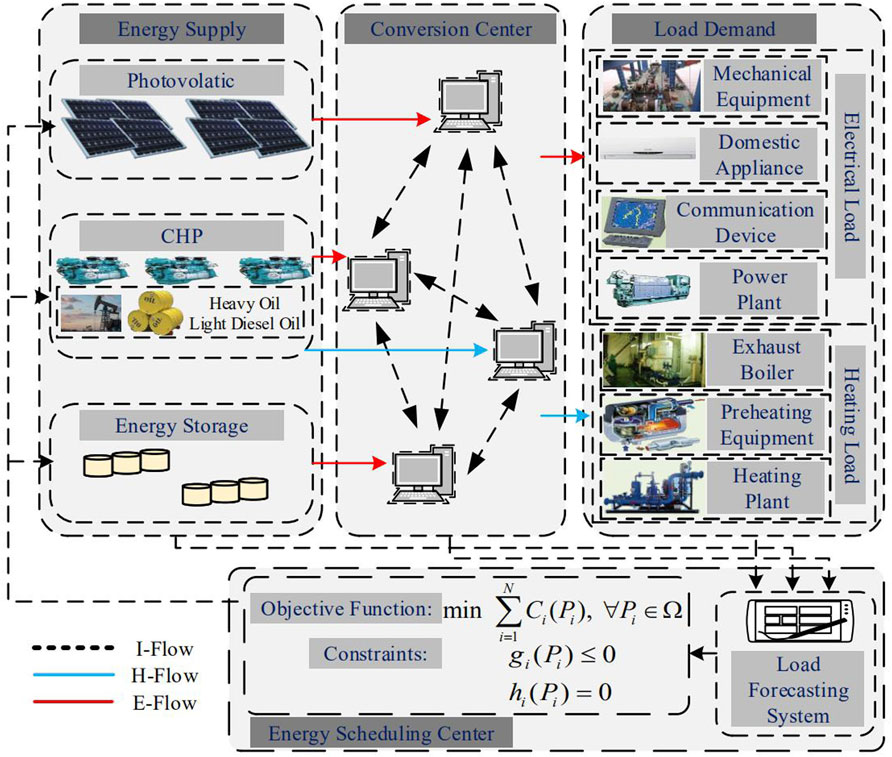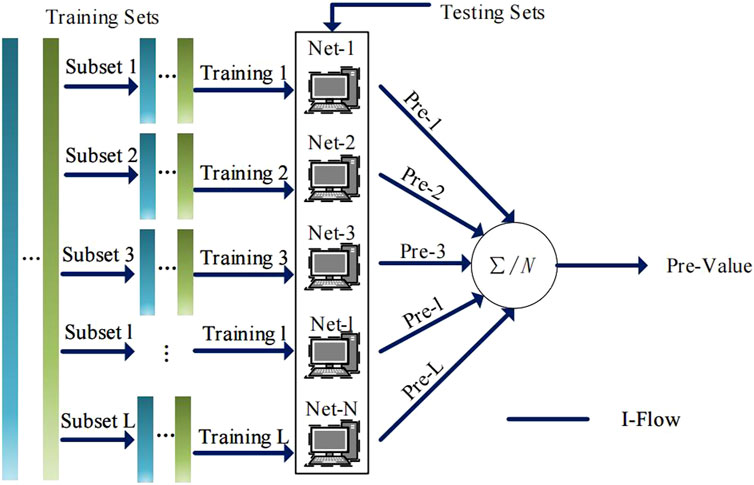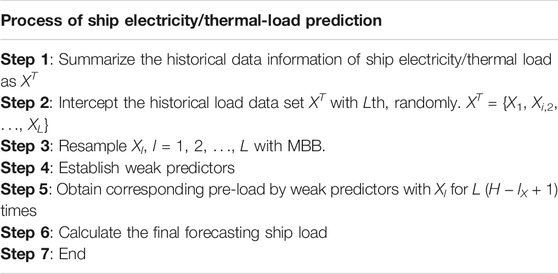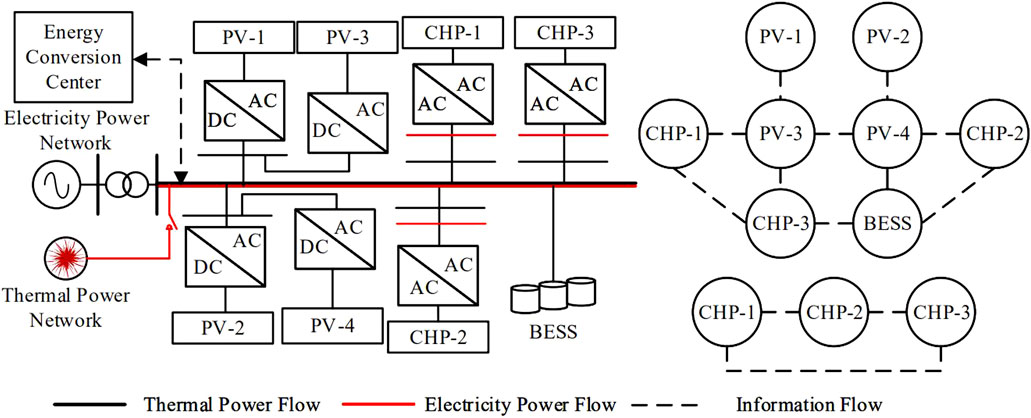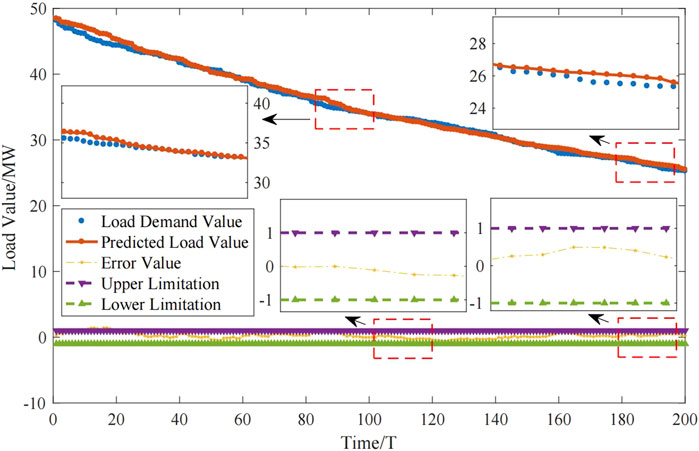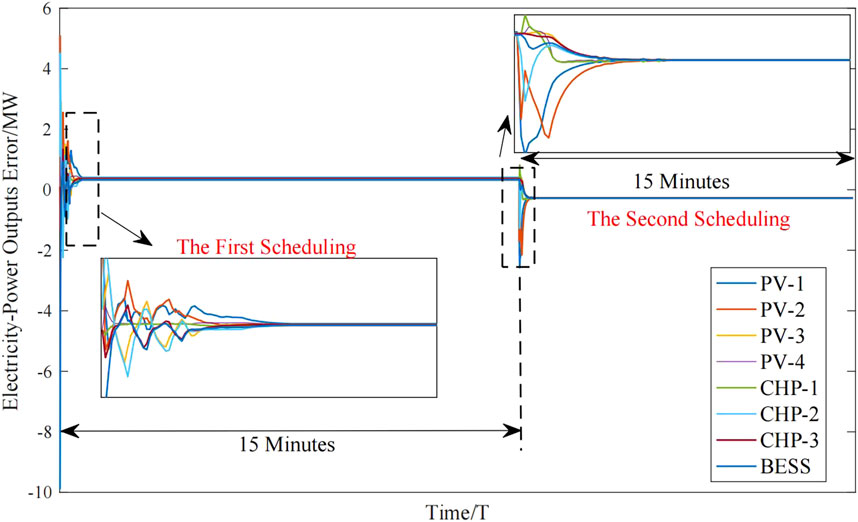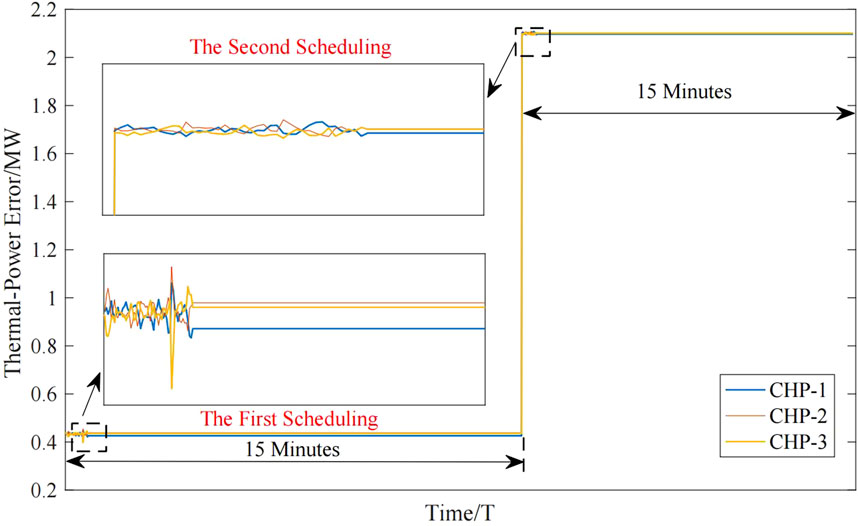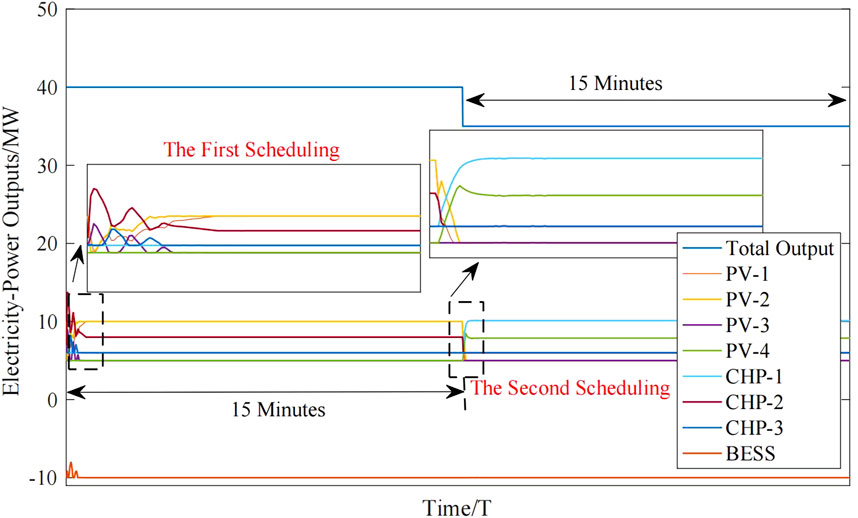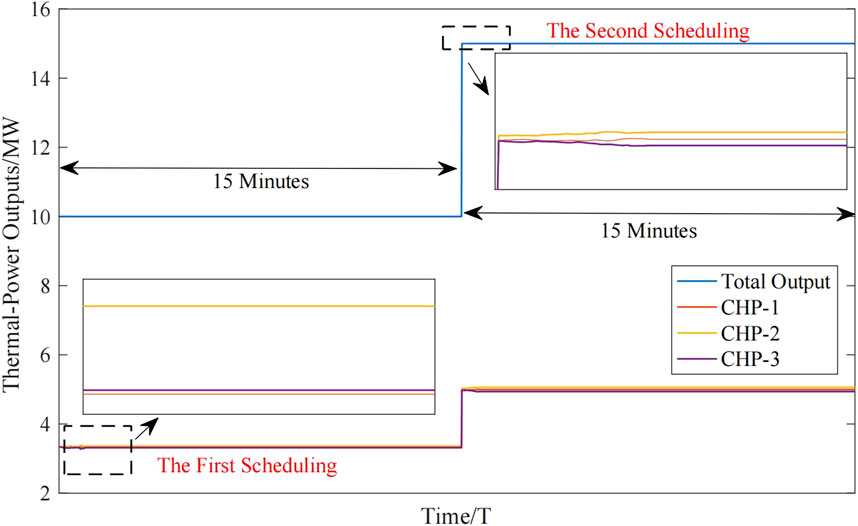Distributed Economic Optimal Scheduling Scheme for Ship-Integrated Energy System Based on Load Prediction Algorithm
- 1Navigation College, Dalian Maritime University, Dalian, China
- 2Maritime Big Data and Artificial Intelligent Application Centre, Dalian Maritime University, Dalian, China
- 3Marine Electrical Engineering College, Dalian Maritime University, Dalian, China
- 4School of Automation Engineering, University of Electronic Science and Technology of China, Chengdu, China
In order to enhance navigation safety and promote environmental protection, this paper takes the problem of energy management in a ship-integrated energy system into consideration. According to the characteristics of navigation, an intelligent ship energy management model, simultaneously considering the social and economic benefits, has been proposed. Meanwhile, this paper analyzes a distributed optimal scheduling problem which considers renewable generation devices and an energy storage system. Combined with an electricity-power system and thermal-power system, we propose an optimal scheduling scheme to accurately meet the actual load demand based on the pre-results analyzed by the ensemble learning short-term load forecasting algorithm. In addition, the related stability analysis is given. Further, a series of simulation results have been presented, which denote that the proposed load forecasting algorithm can accurately analyze the short-term load demand trend, and the proposed optimization algorithm can effectively coordinate economic and environmental protection.
1 Introduction
As we know, a traditional generator which relies on fossil resources will be accompanied by a large amount of greenhouse gases (Sun et al., 2019a; Li et al., 2020a). As one of the areas with the highest consumption of fossil fuels, the shipping industry emits 3–5% of carbon dioxide into the earth every year (Rafiei et al., 2020). In order to reduce the air pollution caused by the shipping industry, the International Maritime Organization (IMO) has issued a series of strict regulations (Czermański et al., 2020), such as limiting the energy efficiency operation index (EEOI) (Fang et al., 2019) and improving energy efficiency, etc. As a new type of ship energy architecture, the ship-integrated energy system (S-IES) improves the utilization efficiency of renewable energy and adjusts the utilization rate of energy, which embodies the deep integration of information technology and energy characteristics. Therefore, with the continuous maturity of intelligent technology (Peng and Wang, 2018; Liang et al., 2020; Li, J. et al., 2020), how to quickly and accurately optimize the scheduling of the ship-integrated energy system, which is based on the concept of sustainable development, has become a hot research topic.
With the continuous development of intelligent technology, its advanced concept has been widely used in various fields (Ye et al., 2018; Liu et al., 2020; Wang et al., 2020; Zhang G. et al., 2020; Lei et al., 2021). Compared with the traditional ship energy system, to reduce fossil energy consumption and pollution emissions, S-IES combines photovoltaic units (PVs), wind turbine units (WTs) with diesel generators (DGs), and combined heat and power generations (CHPs) to form an energy supply system. In addition, unlike traditional ships which rely on mechanical transmission to provide power, ships based on S-IES are all electric ships (AES) which rely on electric propulsion, further improving the controllability and flexibility of ships. Nowadays, in order to improve the rationality and reliability of the ship-integrated energy system, it is essential to establish an optimal scheduling mechanism model, which can accurately describe the whole voyage state. A hybrid energy optimization management model with wind turbines and energy storage equipment is proposed in Li et al. (2020b), considering charging/discharging efficiency and EEOI throughout the whole voyage, which takes the economic benefit as the primary optimization objective to reduce the operation cost. In order to improve the efficiency of energy utilization and ensure the safe operation of power supply equipment, Kanellos et al. (2016) proposes an energy optimization management model to guarantee that the EEOI of ships in different sailing conditions can meet the requirements of pollution emission limits proposed by IMO. Based on the dual consideration of environmental benefits and economic benefits, according to the actual situation of ship navigation, Wen et al. (2021) proposes a joint optimal scheduling model which considers the shore-side electricity system. At present, the research of ship energy optimal management is mostly based on the constraint of supply and demand balance, and is then used to establish a dynamic relationship between the output power of generators and the actual load demand. Thus, an efficient and accurate load forecasting method is the key to improve the reliability of ship energy optimization management.
According to fuel consumption information, meteorological data, and hydrological information, etc., (Teng et al., 2020), based on a broad learning system, proposes a load forecasting method, which can reduce the negative impact of uncertainty in a complex marine environment during navigation operation. Owing to the new energy generators such as WTs and PVs, increasing the uncertainty of the power system, a prediction intervals (PIs) method based on a neural network is proposed to improve the accuracy of load forecasting (Quan et al., 2014). However, the short-term load of a ship has strong nonlinear variation characteristics, i.e., the ship operation in different periods such as departure, arrival, and cruise has quite different load demands. Thus, the traditional method cannot accurately predict the short-term load variation trend. In addition, in view of the actual navigation operation, it is unable to obtain the above information accurately and in a timely manner. Therefore, based on the actual situation, there are still many challenges in ship short-term load forecasting.
Owing to the above situations, we can transform the optimal scheduling problem of the ship-integrated energy system into an energy planning problem which contains a series of complex navigation safety constraints. Considering the total lifecycle cost of a hybrid electric propulsion ship and the storage performance of the battery, an energy management model which can effectively extend the service life of the ship is proposed in Chen et al. (2020) which is based on the depth of the discharge (DOD) constraint of the battery. Taking the minimum fuel consumption as the optimization objective, a power-flow-based energy management model considering a battery energy storage system (BESS) is established in Balsamo et al. (2020), which can improve energy efficiency and reduce pollution emissions, completing ship energy optimal scheduling simultaneously. Fang et al. (2020) presents an optimal management model for all electric ships (AES), which can consider both environmental and economic benefits. It can ensure the navigation operation of the ship and reduce the investment of additional equipment, e.g., ESS by increasing the ship’s power system constraints. However, with the continuous maturity of renewable-related technologies (Farrok et al., 2018), more and more renewable energy supply equipment such as PV units and WT units are connected to the S-IES, which increase the penetration rate of green energy access gradually. And there are a lot of “plug and play” load equipment, such as life load, mechanical, etc. Owing to the above situations, the existing optimization scheduling methods such as the dynamic programming algorithm cannot meet the actual needs of S-IES with strong distributed characteristics. Therefore, it is essential for us to improve the computing speed of the distributed algorithm while dealing with the performance of a ship energy system.
Above all, based on the ship’s navigation characteristics, such as carrying capacity, voyage, and velocity, combined with the constraints of the electricity/thermal energy system, such as supply and demand balance, ramping rate constraints, and energy energy-off constraints, this paper proposes a distributed optimal scheduling method for the ship-integrated energy system with load forecasting. The major contributions of this paper are as follows.
1) This paper proposes a distributed ship-integrated energy system with renewable generation devices and an energy storage system, which can obtain environmental and economic benefits at the same time. Combined with the characteristics of ship navigation, such as safety-sailing, greenhouse emission, and the requirements of electricity/thermal load during the whole voyage, we take the lowest voyage operation cost as the primary optimization objective to form a distributed energy optimization management model for multi-energy ships, so as to realize the economic optimization scheduling of the whole voyage.
2) In order to reduce the waste of fossil energy caused by redundant capacity and improve the accuracy of load response in a ship-integrated energy system, this paper proposes an intelligent algorithm which can quickly and accurately predict the load of navigation. In addition, for improving the efficient and reasonable utilization of energy, a distributed optimal scheduling algorithm for the ship-integrated energy system is proposed as well, which can guarantee safe and reliable navigation and quickly respond to the actual demand of the load equipment simultaneously.
The remainder of this paper is organized as follows. In Section 2, we identify the main features and structures in the ship-integrated energy system. Section 3 proposes an energy management scheme based on load forecasting. Section 4 presents a distributed economic optimal scheduling algorithm for S-IES. According to the analysis of the example and simulation results, the correctness of the proposed viewpoint is fully proved in Section 5. Section 6 summarizes and concludes the points from the paper.
2 Structure and Features in S-IES
The intelligent ship-integrated energy system considered in this paper can accurately predict short-term load demand according to historical navigation information, and owing to the prediction data, combined with the working characteristics of the ship, we can optimize the energy output of the energy supply equipment. Figure 1 shows the basic architecture of the S-IES. According to Figure 1, the S-IES can be roughly divided into an energy supply system, load demand system, energy conversion center, load forecasting center, and energy optimal management center. An energy supply system provides electricity and thermal power for the ship load to maintain normal operation during different conditions; as an energy router, the energy conversion center processes information flow and energy flow simultaneously, and undertakes the task of mutual conversion of electricity and thermal energy; based on navigation constraints and energy constraints, the energy management center adopts a distributed intelligent algorithm to analyze and calculate the energy optimal scheduling scheme in a short period.
2.1 Velocity and Voyage Modeling
Ship navigation can be divided into three different operation conditions, i.e., cruising, anchoring, and docking. Figure 2 is a typical cross section of the ship, in which the voyage and velocity range limits of the ship are indicated. As we know, in the course of sailing, we can adjust the velocity within a certain range based on the actual demand, but the ship must arrive at the ports or intermediate-ports at the specified time. In addition, generally, the ship speed depends on the propulsion power which has a certain relationship with the resistance of sailing. If the propulsion power has a period of t, the velocity Vt can be described as
where, pr1 is a nonnegative constant, which is related to the hull form type, generally taken as 3 (Kanellos et al., 2014); pr2 is the matching parameter of propulsion power and ship speed. Owing to above situations, the mathematical expression of voyage and velocity range limits are as follows, which is given in Feng et al. (2018).
where, Vnt denotes the ship speed at t; σ represents the interval coefficient of ship speed; Distt−1, Distt represent the voyage at a period of t − 1 and t, respectively; Δt represents the specified time interval.
2.2 Energy Supply System Modeling
As mentioned before, in order to improve the environmental friendliness of the ship, we integrate PVs and CHPs into the S-IES. In addition, owing to the high-power ramps and the intermittency caused by renewable energy equipment, a battery energy storage system (BESS) has been considered in the ship to ensure the stability of power output.
1) CHP System Modeling: With the improvement of energy saving and efficiency awareness, CHP, as the preferred equipment which can reduce consumption and increase efficiency, has been widely applied. CHP can utilize the after-heat generated by power generation to other heating loads, such as fuel preheating, etc. It has been considered as the most energy-saving method for power generation, thus CHP has a tendency to be installed on intelligent ships. The operation cost function of CHP, containing fuel consumption, has been modeled as the following convex function in Sun et al. (2019b).
where, n is the number of CHPs;
2) PV Modeling: In order to improve the efficiency of energy utilization and reduce the pollution emissions during the sailing voyage, PV units have been integrated in the S-IES. In addition, the production capacity of a PV panel is not only related to the strength of illumination, degree of angle and panel area, but also related to the ship route and deck inclination angle because of the ship characteristics. Owing to these situations, Long et al. (2020) and Wen et al. (2020) present a mathematical model which can describe the capacity of PV units on ships appropriately.
where, PPV denotes the power output of PV; ηPV,
3) BESS Modeling: Considering that there are many factors affecting solar energy, taking PV units into the energy system directly will lead to S-IES volatility. In addition, the ship energy system will be unstable influenced by the operation of high-load equipment and sudden speed-adjusting. Owing to the above situations, we integrate BESS into the S-IES as additional energy supply generation which can share the pressure with the other device (Gangatharan et al., 2020). The model of charging and discharging can be expressed as follows (Zhang, Y. et al., 2020).
where,
3 Optimal Energy Dispatch Scheme and Load Forecasting on the S-IES
Energy supply side of the S-IES proposed in this paper consists of PVs, CHPs, and BESS. According to the value of load prediction, the energy management center can obtain an optimal scheduling scheme within sailing constraints. Assume that the S-IES contains n-CHPs, m-PVs, a BESS, and other load equipment, such as service load, propulsion load, mechanical load, etc.
3.1 Load Forecasting Algorithm
In order to realize the optimal scheduling of the S-IES, we need to know the short-term load-demand information in a timely manner. Therefore, we need to use the relevance of specific routes to make a predictive analysis of the load-demand information, and make a reliable prediction of the trend of ship load demand. A deep learning algorithm can collect feature information from ship historical load data through multiple hidden layers, but it is easy to fall into a local optimal solution and other problems to some extent (Zhang, J. et al., 2020; Wang et al., 2021). In order to solve the above contradictory problems, the ensemble learning theory, containing the Bagging method and Bossting method which are two popular algorithms based on resampling for load prediction problems Feng et al. (2018) has received widespread consideration because of its excellent performance in numerical prediction situations. Therefore, this paper proposes a ship short-term load forecasting algorithm based on ensemble learning; the basic structure and framework can be seen in Figure 3.
Considering the proposed load prediction algorithm, the historical load data set can be arranged as XT, firstly. And then, we can obtain the load data subsets Xl by resampling which needs to ensure the samples are not related (i.e., the factors within it without any repeated data), where l = 1, 2, …, L. It is worth noting that in the process of sampling and resampling for historical ship load, the time dependence of load data sets should be guaranteed at all times. In addition, for increasing the accuracy and reliability of the proposed algorithm, this paper utilizes Moving Block Bootstrap (MBB) during the process of resampling. Suppose load data subset Xl has H load data factors and samples H − lX + 1 times continuously and repeatedly, where lX denotes the length of resampling load data subsets. Then, the sampling process of ship historical load data at this time can be seen in Figure 4 and Table 1, the resampling load data subsets can be represented as follows.
According to the ship-load forecasting problem, we need to repeat the above processes L times to obtain the independent load data training subset X = [X1, X2, …, XL].
3.2 Optimal Energy Dispatch Scheduling Scheme
3.2.1 Optimal Goal Function
The S-IES proposed in this paper considers the environmental and economic benefits comprehensively. And proposes an optimal management mechanism which takes the lowest operation cost as the primary optimization objective, to meet the various load-demand constraints during different working conditions such as berthing and cruising. Owing to the generation equipment installed in the ship, in this paper, the objective function can be separated into three parts which contain the CHPs-cost, PVs-cost, and excitation parameters of BESS. The mathematical model can be represented as the following form.
where, CCHP, CPV are the operation cost of CHPs and PVs; NT denotes the sum of time slots; dj,1, dj,0 are the operating parameters of PVs;c0 denotes the influence factor; ϒBESS can be expressed as a penalty coefficient which can enhance the participation of BESS and improve the energy efficiency.
RemarkSince the above mentioned equipment has a longer service life, we assume that they have little loss during the energy optimization management scheduling in the single sailing voyage. Therefore, the cost of equipment maintenance does not need to be considered in the optimization objective function.
3.2.2 Constraints
Considering the particularity of ship sailing voyages, this paper does not only consider the conventional constraints in energy management such as the power balance constraint and power output constraint, but also the navigation constraints Eqs 1-3, interruption of electricity/heating constraint, ramping-rate constraint, and energy efficiency operation index (EEOI) constraints. The specific descriptions are as follows.
1) Electricity/Heating Power Balance Constraints: In order to ensure the normal operation of all load equipment such as the propulsion system and service load, we need to guarantee that the sum of the electrical power output of CHPs, PVs, and ESS matches the electrical load, and the thermal power output of CHPs can meet the thermal-load demand. In addition, the energy conversion center undertakes the mutual conversion of electricity and heating power, i.e., when the thermal output cannot meet the load demand, the electric energy could be converted into thermal power as an additional heating supplier to ensure the normal operation of heating-load equipment. We can express the balance constraints as the following.
where, LP,t, LH,t represent the electricity and thermal load value at the period of t, respectively; ηEX is the conversion efficiency parameter; ΔLP,t denotes the conversion of electricity into thermal load value; ΔLH,t is the thermal power supplied by electricity generators.
RemarkWhen BESS is discharging as a power supply equipment,
2) Power Outputs Constraints: It is noted that we should ensure the reliable and safe working conditions of the power-supply equipment during the whole sailing voyage. Therefore, it is essential to restrict its output power to improve the safety of the energy management model in the S-IES. In this paper, combined with the actual ship situations, the minimum and maximum limits on the power outputs of each equipment are as follows.
where,
3) Electricity and Thermal Power-off Constraints: Considering the difference between the traditional power system, the S-IES should ensure that the critical equipment operates normally during the whole voyage owing to the navigation characteristics. Based on the consideration of ship safety, we take the restriction of electricity and thermal power output as an additional constraint, i.e., the anti-power-off constraint. The mathematical model is as follows.
According to Eq. 10, we can confirm that the electricity/thermal power can meet the must-run load demand while the highest capacity equipment breaks down suddenly. LP,M is the must-run electricity load such as a propulsion system, communication and navigation equipment; LH,M is the must-run thermal load such as fuel preheating equipment; ΔLH,max denotes the maximal thermal power generated by the electricity power conversion. Owing to Eq. 12, we can ensure that must-run load devices such as communication equipment, propulsion system, can maintain normal operation when the highest capacity generator breaks down.
4) EEOI Constraints: EEOI, as a crucial detection parameter, is essential to evaluate the greenhouse gas emissions during ship navigation. Therefore, in order to improve the environmental protection of sailing operation, the EEOI constraint is added in this paper to ensure that the pollution emission of each navigation period is lower than the preset value. The mathematical equation on the EEOI constraint (Kanellos, 2014) can be expressed as follows.
where, EEOI1 is the ship index during sailing; CO2 denotes the value of carbon dioxide emissions; MLoad means the ship carrying capacity; c2,i, c1,i, and c0,i are the coefficients between power outputs and greenhouse gas emission. It is noted that the carbon emission function is a quadratic convex, therefore, this paper enlarges the molecular part to obtain a better form of calculation, i.e.,
4 Distributed Economic Optimal Scheduling Scheme on the S-IES
Owing to the energy system considered, this paper installed a large number of new energy equipment, so the system has strong distributed characteristics. In addition, the energy system and communication network have been integrated in the system with the power outputs and load-demand information transmitted among the devices. Based on the above situations, this paper proposes a distributed economic optimal scheduling scheme for the S-IES, which ensures the system can meet the load demand and obtain the minimal system operation cost, as well.
4.1 Graph Theory Infrastructure
In this paper, V = {1, 2, …, N} is regarded as a set of nodes in the system, and the edge set can be expressed as E ⊆ V × V. Therefore, based on the edge set and node set, the communication topology in the system can be expressed as Ξ = (V, E). If node i and node j are neighbors to each other, then we can describe the neighbor node set of i as Nij = {j ⊆ V∣(Vi, Vj) ⊆ E} (Ma et al., 2021). And the connection weight between two nodes can be expressed as ωij, which should ensure that ωij > 0 when two nodes are neighbors; ωij = 0 when there is no communication between two nodes. If the communication structure Ξ considered in this paper is undirected and connected, i.e., there is a path between any two nodes then ωij = ωji.
RemarkAccording to the above theory, we can obtain that
4.2 Problem Statement and Distributed Optimization Algorithm
The optimal scheduling model on the S-IES mentioned above is based on the balance of supply and demand which establishes the relationship between economic benefits and ship operation constraints. Generally, the optimal scheduling in this paper can be described as a problem on min{CCHP + CPV + ϒBESS}. The alternating direction method of multipliers algorithm (ADMM) could be used for energy management problems with large-scale constraints, and it is decomposable, as well (Zhang et al., 2017). Therefore, this paper proposes a distributed economic optimal scheduling scheme based on ADMM, which will be introduced from three aspects, i.e., problem transformation, optimizing the iterative process, and convergence judgment.
4.2.1 Problem Transformation
Owing to the fact that the ADMM algorithm cannot deal with the optimal scheduling problem with inequality constraints (Falsone et al., 2021), this paper introduces relaxation variables S = {S1, …, Sm} in the energy management. Thus, inequality constraints can be changed into equality constraints as HQ = L, where Q = {P1, …, Pn, S1, …, Sm}.
4.2.2 Optimizing the Iterative Process
Based on the distributed communication structure, the proposed algorithm will optimize the power outputs of power-supply equipment, equipment operation errors, and the Lagrange multipliers. The K + 1th iteration expression about the above variables are as follows, where c denotes the step size; Ad is the parameter of the coupling constraint; ΔQK represents the operation error.
4.2.3 Convergence Judgment
It is noted that the objective function C considered in this paper is convex and the set Q is convex and compact. In addition, we assume that we can find at least one existing saddle point in the above optimal scheduling problem. According to the above assumptions, we find that the sequences of
Thus, we find that the sequence
5 Case Study
According to the simulation experimental information of the short-term load forecasting algorithm introduced in Section 3.1, this chapter will optimize the scheduling of the S-IES based on the proposed distributed optimal economic scheme, and verify the effectiveness according to the simulation experimental results.
5.1 Introduction to the Simulation System
This chapter considers a simulation system which contains 3-CHPs, 4-PVs, and a BESS. According to the short-term load forecasting algorithm and the distributed optimization scheme, generation units (i.e., CHPs, PVs, BESS) will provide energy to the electricity-power network and the thermal-power network to meet the load demand. In addition, each device can exchange power information with their neighbors. The physical and information topology on electricity/thermal power can be seen in Figure 5. The operation cost parameters are shown in Table 2.
5.2 Analysis on Simulation Results
5.2.1 Ship-Load Forecasting Algorithm Analysis
Based on the data samples of historical ship load, the algorithm intercepts the data repeatedly first, which obtains the ship-load resampling subsets. According to the above load data sets, training networks (i.e., weak predictor models) based on BPNN are established in the case study. Meanwhile, the corresponding predicted ship load can be calculated, and then we can obtain the final forecasting ship-load value by the stronger predictor which adds them up and takes an average of them. According to the above process, we can increase the weight of the weak predictor with a smaller load forecasting error and reduce the weight of the weak predictor with a large load forecasting error.
This paper selects the historical electricity/thermal load data from the intelligent ship during the whole sailing voyage (Teng et al., 2020) to analyze the short-term load forecasting model. According to the proposed algorithm, the output trajectory of ship-load forecasting results can be obtained by simulation which is shown in Figure 6. It can be seen from the figure that the two curves of load forecasting trajectory and real load trajectory have obvious similarity. In addition, this paper takes the NN method for load forecasting as a comparative algorithm. Owing to the simulation, Figure 6 and the error comparison in Table 3 can verity that the proposed short-term ship-load forecasting algorithm can accurately predict the trend of ship-load demand for the S-IES.
5.2.2 Distributed Energy Management Scheduling Analysis
Based on the above simulation system, we carry out two optimal scheduling simulations according to the load forecasting value. The virtual electricity-power load demand are 40 and 35 MW; the virtual thermal-power load demand are 10 and 15 MW, which have been predicted by the load forecasting algorithm mentioned above. The parameters of electricity/thermal power outputs and initial value can be seen in Table 4.
According to the above virtual load, based on the proposed distributed economic optimal scheduling algorithm, the optimal scheduling scheme of each piece of equipment under the power balance constraints, ship navigation constraints, and equipment safety constraints [i.e., (8)–(11)] is solved which satisfies the electricity/thermal load demand and the constraints of BESS. In this example, in order to meet the electricity/thermal load demand, the relevant generation units need to adjust their output power to cope with the change of load demand. Figure 7 is the trajectory of the electricity-power outputs error, and the thermal-power outputs error is shown in Figure 8. According to the above two figures, it is noted that after 60 optimization iterations, the total power outputs of the system satisfy the first virtual load scheduling goal and after 100 optimization iterations, the system meets the second virtual load scheduling goal.
The electricity-power and thermal-power outputs trajectories can be seen in Figures 9, 10. According to the curves of total power outputs, it is noted that the optimization scheme analyzed by the proposed algorithm can deal with the energy management problem based on the S-IES, effectively. The power outputs have little fluctuation, which can meet the demand of electricity load and thermal load in a timely manner. The optimal scheduling scheme based on twice virtual electricity/thermal load energy management can be seen in Table 5.
According to the above results, BESS is in the charging state during the twice optimal scheduling, and the total power outputs of renewable energy equipment, i.e., 4-PVs, are significantly higher than that of traditional fuel energy supply equipment, i.e., 3CHPs. Therefore, it can be proved that the optimal scheduling scheme based on the optimization method proposed in this paper can effectively improve the environmental benefits of the ship-integrated energy system, which can reduce the greenhouse gas emission during the sailing voyage as well.
It can be seen from the above results that under the reasonable scheduling strategy, the S-IES could achieve the coordination and optimization of multiple energy sources, and significantly improve the flexibility and economic efficiency of the energy system on an intelligent ship.
6 Conclusion
In this paper, an integrated energy system in an intelligent ship, considering the characteristics of the electricity-power system and thermal-power system, has been constructed, which improves the utilization efficiency of energy and reduces greenhouse gas emissions. Simultaneously, this paper presents a short-term load forecasting method based on an ensemble learning algorithm, which can quickly and accurately predict the load demand during the whole voyage. In addition, for ensuring reliable and stable navigation, this paper proposes a distributed optimal scheduling scheme, which can deal with the problem of energy management in the S-IES suitably. It is noted that the distributed scheduling scheme proposed in this paper can obtain the social benefits and ensure safe sailing synchronously, which can be proved by the simulation results. In future, for promoting the intellectualization of the maritime industry, volatility and disturbance factors will be further analyzed.
Data Availability Statement
The original contributions presented in the study are included in the article/Supplementary Material, further inquiries can be directed to the corresponding author.
Author Contributions
QS designed the experiments, research methods, and the format analysis. The tools analysis, data processing, and writing the original draft were carried out by YZ. FT performed the writing-review on references. TL contributed to proof reading and project/organization management. All authors have read and agreed to the published version of the manuscript.
Funding
This work is supported in part by the National Natural Science Foundation of China (under grant nos. 51939001, 61803064, 61751202, 61903092, 61976033, and U1813203); the Science and Technology Innovation Funds of Dalian (under grant no. 2018J11CY022); the Liaoning Revitalization Talents Program (under grant nos. XLYC1908018 and XLYC1807046); the Natural Science Foundation of Liaoning (2019-ZD-0151, 20170540098); the Fundamental Research Funds for the Central Universities (under grant nos. 3132019345, 3132020103, and 3132020125).
Conflict of Interest
The authors declare that the research was conducted in the absence of any commercial or financial relationships that could be construed as a potential conflict of interest.
Publisher’s Note
All claims expressed in this article are solely those of the authors and do not necessarily represent those of their affiliated organizations, or those of the publisher, the editors and the reviewers. Any product that may be evaluated in this article, or claim that may be made by its manufacturer, is not guaranteed or endorsed by the publisher.
References
Balsamo, F., De Falco, P., Mottola, F., and Pagano, M. (2020). Power Flow Approach for Modeling Shipboard Power System in Presence of Energy Storage and Energy Management Systems. IEEE Trans. Energ. Convers. 35 (4), 1944–1953. doi:10.1109/TEC.2020.2997307
Chen, L., Tong, Y., and Dong, Z. (2020). Li-Ion Battery Performance Degradation Modeling for the Optimal Design and Energy Management of Electrified Propulsion Systems. Energies 13, 1629. doi:10.3390/en13071629
Czermański, E., Pawłowska, B., Oniszczuk-Jastrzabek, A., and Cirella, G. T. (2020). Decarbonization of Maritime Transport: Analysis of External Costs. Front. Energ. Res. 8, 28. doi:10.3389/fenrg.2020.00028
Falsone, A., Notarnicola, I., Notarstefano, G., and Prandini, M. (2020). Tracking-ADMM for Distributed Constraint-Coupled Optimization. Automatica 117, 108962. doi:10.1016/j.automatica.2020.108962
Fang, S., Xu, Y., Li, Z., Ding, Z., Liu, L., and Wang, H. (2019). Optimal Sizing of Shipboard Carbon Capture System for Maritime Greenhouse Emission Control. IEEE Trans. Ind. Appl. 55 (6), 5543–5553. doi:10.1109/TIA.2019.2934088
Fang, S., Xu, Y., Wen, S., Zhao, T., Wang, H., and Liu, L. (2020). Data-Driven Robust Coordination of Generation and Demand-Side in Photovoltaic Integrated All-Electric Ship Microgrids. IEEE Trans. Power Syst. 35 (3), 1783–1795. doi:10.1109/TPWRS.2019.2954676
Farrok, O., Islam Sheikh, M. R., Guo, Y., Zhu, J., and Lei, G. (2018). Oceanic Wave Energy Conversion by a Novel Permanent Magnet Linear Generator Capable of Preventing Demagnetization. IEEE Trans. Industry Appl. 54 (6), 6005–6014. doi:10.1109/TIA.2018.2863661
Feng, W., Huang, W., and Ren, J. (2018). Class Imbalance Ensemble Learning Based on the Margin Theory. Appl. Sci. 8, 815. doi:10.3390/app8050815
Gangatharan, S., Rengasamy, M., Elavarasan, R. M., Das, N., Hossain, E., and Sundaram, V. M. (2020). A Novel Battery Supported Energy Management System for the Effective Handling of Feeble Power in Hybrid Microgrid Environment. IEEE Access 8, 217391–217415. doi:10.1109/ACCESS.2020.3039403
Kanellos, F. D., Tsekouras, G. J., and Hatziargyriou, N. D. (2014). Optimal Demand-Side Management and Power Generation Scheduling in an All-Electric Ship. IEEE Trans. Sustainable Energ. 5 (4), 1166–1175. doi:10.1109/TSTE.2014.2336973
Kanellos, F. D., Anvari-Moghaddam, A., and Guerrero, J. M. (2016). Smart Shipboard Power System Operation and Management. Inventions 1, 22. doi:10.3390/inventions1040022
Kanellos, F. D. (2014). Optimal Power Management with GHG Emissions Limitation in All-Electric Ship Power Systems Comprising Energy Storage Systems. IEEE Trans. Power Syst. 29 (1), 330–339. doi:10.1109/TPWRS.2013.2280064
Lei, L., Gao, T., Liu, Y., and Tong, S. (2021). Time-varying IBLFs-Based Adaptive Control of Uncertain Nonlinear Systems with Full State Constraints. Automatica 129, 109595. doi:10.1016/j.automatica.2021.109595
Li, Y., Gao, W., Zhang, H., and Zhou, J. (2020a). A Distributed Double-Newton Descent Algorithm for Cooperative Energy Management of Multiple Energy Bodies in Energy Internet. IEEE Trans. Ind. Inform. 17 (9), 5993–6003. doi:10.1109/TII.2020.3029974
Li, Y., Gao, D. W., Gao, W., Zhang, H., and Zhou, J. (2020b). Double-Mode Energy Management for Multi-Energy System via Distributed Dynamic Event-Triggered Newton-Raphson Algorithm. IEEE Trans. Smart Grid 11 (6), 5339–5356. doi:10.1109/TSG.2020.3005179
Li, J., Zhang, G., Liu, C., and Zhang, W. (2020). COLREGs-Constrained Adaptive Fuzzy Event-Triggered Control for Underactuated Surface Vessels with the Actuator Failures. IEEE Trans. Fuzzy Syst. doi:10.1109/TFUZZ.2020.3028907
Liang, H., Zhang, Y., Huang, T., and Ma, H. (2020). Prescribed Performance Cooperative Control for Multi-Agent Systems with Unknown Control Directions and Input Quantization. IEEE Trans. Cybern. 50 (5), 1810–1819. doi:10.1109/TCYB.2019.2893645
Liu, Z., Saberi, A., Stoorvogel, A. A., and Nojavanzadeh, D. (2020). H∞ Almost State Synchronization for Homogeneous Networks of Non-introspective Agents: A Scale-free Protocol Design. Automatica 122, 109276. doi:10.1016/j.automatica.2020.109276
Long, H., Xu, S., Lu, X., Yang, Z., Li, C., Jing, J., et al. (2020). Data-Driven Hybrid Equivalent Dynamic Modeling of Multiple Photovoltaic Power Stations Based on Ensemble Gated Recurrent Unit. Front. Energ. Res. 8, 185. doi:10.3389/fenrg.2020.00185
Ma, D., Hu, X., Zhang, H., Sun, Q., and Xie, X. (2021). A Hierarchical Event Detection Method Based on Spectral Theory of Multidimensional Matrix for Power System. IEEE Trans. Syst. Man, Cybern. Syst. 51 (4), 2173–2186. doi:10.1109/TSMC.2019.2931316
Peng, Z., and Wang, D. (2018). Distributed Maneuvering of Autonomous Surface Vehicles Based on Neurodynamic Optimization and Fuzzy Approximation. IEEE Trans. Control. Syst. Technol. 26 (3), 1083–1090. doi:10.1109/TCST.2017.2699167
Quan, H., Srinivasan, D., and Khosravi, K. (2014). Short-Term Load and Wind Power Forecasting Using Neural Network-Based Prediction Intervals. IEEE Trans. Neural Networks Learn. Syst. 25 (2), 303–315. doi:10.1109/TNNLS.2013.2276053
Rafiei, M., Boudjadar, J., and Khooban, M. -H. (2020). Energy Management of a Zero-Emission Ferry Boat with a Fuel-Cell-Based Hybrid Energy System: Feasibility Assessment. IEEE Trans. Ind. Electron. 68 (2), 1739–1748. doi:10.1109/TIE.2020.2992005
Sun, Q., Fan, R., Li, Y., and Huang, B., (2019a). A Distributed Double-Consensus Algorithm for Residential We-Energy. IEEE Trans. Ind. Inform. 15 (8), 4830–4842. doi:10.1109/TII.2019.2921431
Sun, Q., Zhang, N., You, S., and Wang, J. (2019b). The Dual Control with Consideration of Security Operation and Economic Efficiency for Energy Hub. IEEE Trans. Smart Grid 10 (6), 5930–5941. doi:10.1109/TSG.2019.2893285
Teng, F., Shan, Q., and Li, T. (2020). Intelligent Ship Integrated Energy System and its Distributed Optimal Scheduling Algorithm. Acta Autom. Sin. 46, 1809–1817. doi:10.16383/j.aas.c200176
Wang, R., Sun, Q., Ma, D., and Hu, X. (2020). Line Impedance Cooperative Stability Region Identification Method for Grid-Tied Inverters under Weak Grids. IEEE Trans. Smart Grid 11 (4), 2856–2866. doi:10.1109/TSG.2020.2970174
Wang, J., Wang, Z., Chen, X., and Qiu, J. (2021). Synchronization Criteria of Delayed Inertial Neural Networks with Generally Markovian Jumping. Neural Networks 139, 64–76. doi:10.1016/j.neunet.2021.02.004
Wen, S., Zhao, T., Tang, Y., Xu, Y., Zhu, M., and Huang, Y. (2020). A Joint Photovoltaic-dependent Navigation Routing and Energy Storage System Sizing Scheme for More Efficient All-Electric Ships. IEEE Trans. Transp. Electrification 6 (3), 1279–1289. doi:10.1109/TTE.2020.3015983
Wen, S., Zhao, T., Tang, Y., Xu, Y., Zhu, M., Fang, S., et al. (2021). Coordinated Optimal Energy Management and Voyage Scheduling for All-Electric Ships Based on Predicted Shore-Side Electricity Price. Trans. Industry Appl. 57 (1), 139–148. doi:10.1109/TIA.2020.3034290
Ye, P., Wang, T., and Wang, F. (2018). A Survey of Cognitive Architectures in the Past 20 Years. IEEE Trans. Cybernetics 48 (12), 3280–3290. doi:10.1109/TCYB.2018.2857704
Zhang, H., Li, Y., Gao, D. W., and Zhou, J. (2017). Distributed Optimal Energy Management for Energy Internet. IEEE Trans. Ind. Inform. 13 (6), 3081–3097. doi:10.1109/TII.2017.2714199
Zhang, G., Yao, M., Xu, J., and Zhang, W. (2020). Robust Neural Event-Triggered Control for Dynamic Positioning Ships with Actuator Faults. Ocean Eng. 207, 107292. doi:10.1016/j.oceaneng.2020.107292
Zhang, J., Chen, X., and Gu, G. (2020). State Consensus for Discrete-Time Multi-Agent Systems over Time-Varying Graphs. IEEE Trans. Automatic Control. 66 (1), 346–353. doi:10.1109/TAC.2020.2979750
Keywords: ship integrated energy system, energy management, renewable generation devices, load forecasting algorithm, distributed optimal scheduling, ensemble learning algorithm
Citation: Zhang Y, Shan Q, Teng F and Li T (2021) Distributed Economic Optimal Scheduling Scheme for Ship-Integrated Energy System Based on Load Prediction Algorithm. Front. Energy Res. 9:720374. doi: 10.3389/fenrg.2021.720374
Received: 04 June 2021; Accepted: 29 July 2021;
Published: 17 September 2021.
Edited by:
Qiuye Sun, Northeastern University, ChinaReviewed by:
Narottam Das, Central Queensland University, AustraliaFanlin Meng, University of Essex, United Kingdom
Geyang Xiao, Zhejiang Lab, China
Xiting Peng, Shenyang University of Technology, China
Copyright © 2021 Zhang, Shan, Teng and Li. This is an open-access article distributed under the terms of the Creative Commons Attribution License (CC BY). The use, distribution or reproduction in other forums is permitted, provided the original author(s) and the copyright owner(s) are credited and that the original publication in this journal is cited, in accordance with accepted academic practice. No use, distribution or reproduction is permitted which does not comply with these terms.
*Correspondence: Qihe Shan, shanqihe@dlmu.edu.cn
 Yuxin Zhang
Yuxin Zhang Qihe Shan
Qihe Shan Fei Teng
Fei Teng Tieshan Li
Tieshan Li